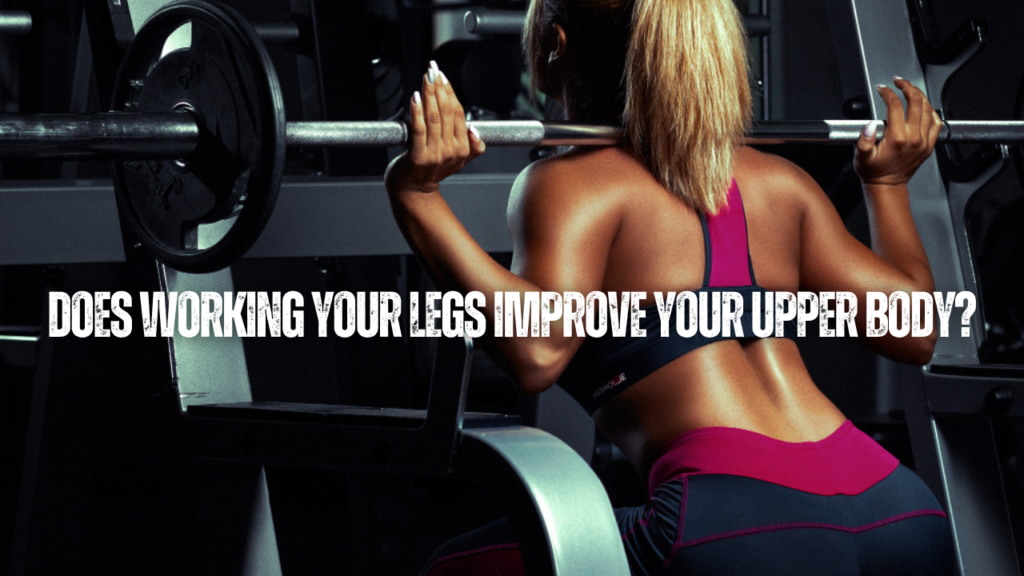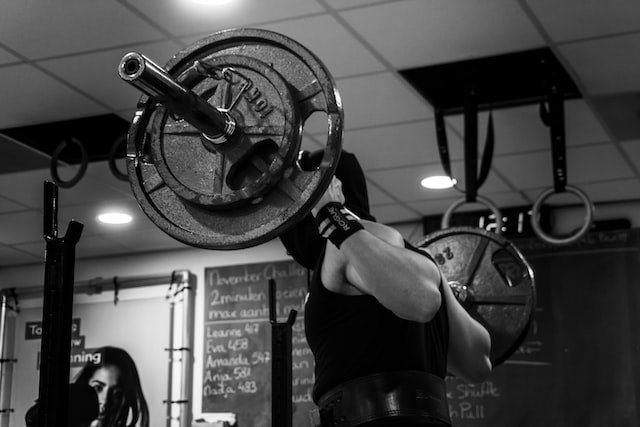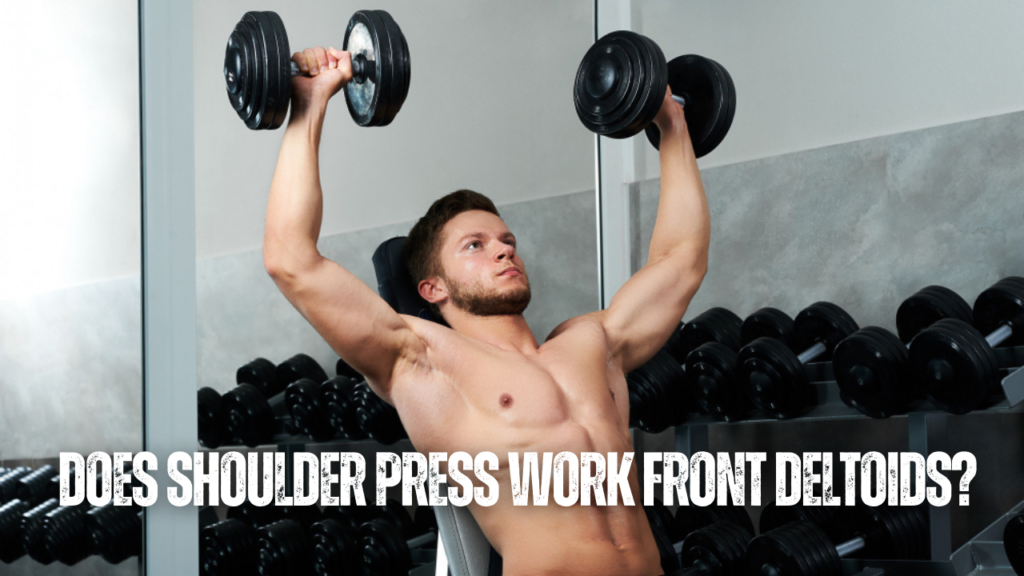
Does Working Your Legs Improve Your Upper Body? Answers Here
Have you ever wondered if working your legs can improve your upper body strength? It’s a common question among fitness enthusiasts who want to maximise their workout routine and see results all over their body.
While it may seem counterintuitive, there is evidence to suggest that working your legs can indeed improve your upper body strength.
In this article, we’ll explore the science behind this theory and provide tips on how to incorporate leg workouts into your overall fitness routine for a full-body transformation. So, if you’re ready to take your fitness to the next level, let’s dive in and explore the relationship between leg workouts and upper body strength.
Does Working Your Legs Improve Your Upper Body?
Working your legs can certainly improve your upper body strength due to several factors. Firstly, leg exercises such as squats, lunges, and deadlifts engage large muscle groups that require a significant amount of energy and effort to complete. This release of energy and effort triggers the release of hormones, including testosterone and growth hormone, which can help to promote muscle growth and recovery throughout the body. Additionally, the neurological stimulus generated by leg workouts can have an indirect effect on upper body strength. When performing compound exercises that require the use of multiple muscle groups, such as a squat, the upper body is used to control and stabilize the load. This coordinated effort between the upper and lower body can improve overall body mechanics, leading to better muscle activation and recruitment. Moreover, working your legs can also have a direct effect on the upper body. Leg exercises can engage the upper body in a variety of ways, such as through the use of weights or by incorporating upper body movements into the exercise itself. This type of training can help to improve posture, balance, and the overall balance of strength between the upper and lower body. Finally, leg workouts can also accelerate fat loss, which can help to improve the appearance of the entire body. The muscle fibre recruitment that occurs during leg workouts can increase metabolism and promote fat burning throughout the body, leading to overall weight loss and improved body composition.
Now that we’ve explored the idea of whether leg work can enhance your upper body, let’s delve more deeply into this concept…
1. Large muscle groups
Your legs are a vital part of your body, and they are made up of some of the largest and strongest muscle groups in your body. The muscles involved in your legs are divided into two main groups, the anterior muscles located in the front of the leg, and the posterior muscles located at the back of the leg.
The anterior muscles are responsible for extension and include the quadriceps femoris, which is the largest muscle in your body, and consists of the vastus lateralis, vastus medialis, vastus intermedius, and rectus femoris. These muscles are primarily used for extending the leg at the knee joint, which is essential for many activities such as walking, running, and jumping.
On the other hand, the posterior muscles are responsible for flexion and include the hamstrings, gluteus maximus, and gastrocnemius. The hamstrings consist of three muscles, the biceps femoris, semitendinosus, and semimembranosus, which are responsible for flexing the knee and extending the hip. The gluteus maximus, which is the largest muscle in your buttocks, is responsible for hip extension, while the gastrocnemius, located in the calf, is responsible for plantarflexion or pointing the foot downwards.
Working these large muscle groups can have a significant impact on your overall fitness and health, promoting muscle growth and development, increased metabolism and calorie burn, and improved body composition.
2. Release of hormones
Working your legs can have a significant impact on hormone release, which can ultimately improve your upper body strength. This is because leg exercises such as squats, deadlifts, and lunges engage large muscle groups, which require significant energy and effort to complete. This effort triggers a hormonal response from the body, including the release of testosterone and growth hormone.
Testosterone is an essential hormone for muscle growth and repair, and it is naturally produced in both men and women. When you engage in leg exercises, your body produces more testosterone than usual, which can help to promote muscle growth and recovery throughout the entire body, including the upper body.
Growth hormone, on the other hand, plays a crucial role in overall growth and development. It is responsible for stimulating cell reproduction and regeneration, which can help to repair and rebuild muscle tissue. Leg workouts have been shown to promote the release of growth hormone, which can help to improve muscle recovery and growth throughout the entire body.
In addition to testosterone and growth hormone, leg workouts can also trigger the release of other hormones, including adrenaline and cortisol. Adrenaline helps to promote energy and focus, which can be useful for high-intensity workouts, while cortisol helps to regulate stress levels and maintain homeostasis.
3. Neurological stimulus
Neurological stimulus refers to the ability of the nervous system to send and receive signals between the brain and muscles, which is essential for proper movement and coordination. Leg exercises require significant coordination and balance, which can improve the communication between your brain and muscles.
In addition to improving coordination, leg exercises can also enhance the activation of the central nervous system (CNS). The CNS is responsible for controlling all voluntary and involuntary movements in the body, and improving its function can have a significant impact on overall strength and performance. When you perform leg exercises, the CNS is activated to control the movement of the legs, but it also engages other muscle groups, including the upper body.
For example, when performing a squat, your core and back muscles are engaged to stabilize your body, while your arms are used to hold onto the weight. This engages the entire body, promoting better communication between the CNS and muscle groups throughout the body.
Compound exercises such as deadlifts and lunges can also have a similar impact on neurological stimuli. These exercises engage multiple muscle groups simultaneously, promoting better communication between the brain and muscles, which can ultimately lead to improved strength and performance throughout the entire body.
4. Improves overall body mechanics
Working your legs can improve overall body mechanics, which can ultimately lead to improved upper body strength and function. Leg exercises require proper form and technique, which can help to promote better overall body alignment and mechanics. For example, when performing a squat, proper form requires keeping your chest up and engaging your core and back muscles to maintain proper alignment. This promotes better overall posture and mechanics, which can lead to improved upper body strength and function.
Similarly, deadlifts and lunges require proper form and technique to maintain proper alignment and mechanics. These exercises engage the core and back muscles to maintain proper alignment and promote better overall body mechanics.
In addition to promoting better overall body mechanics during leg exercises, improving lower body strength can also have a significant impact on overall body mechanics. Strong leg muscles can help to support and stabilize the body during various movements and activities, ultimately promoting better overall body mechanics.
For example, when running or jumping, strong leg muscles can help to support the body and absorb shock, reducing the impact on the joints and promoting better overall mechanics. This can ultimately lead to improved upper body function and strength.
Related: Why Is My Leg Press So Much Stronger Than My Squat?
5. Control and stabilisation
Leg exercises such as squats, lunges, and deadlifts require significant stability and balance, which engages the muscles in the upper body to stabilize and support the weight being lifted. For example, when performing a barbell back squat, the weight is loaded onto the upper back, and the legs are used to lift and support the weight. However, the upper body is also engaged to stabilize and support the weight being lifted, promoting better overall upper body strength and function.
Similarly, deadlifts and lunges require significant upper body engagement to maintain proper form and alignment. These exercises require the upper body to engage and stabilize the weight being lifted, promoting better overall strength and function throughout the entire body.
In addition to promoting better upper body engagement during leg exercises, improving lower body strength can also have a significant impact on overall body mechanics and stability. Strong leg muscles can help to support and stabilize the body during various movements and activities, ultimately promoting better overall stability and function.
For example, when carrying heavy loads or performing functional movements such as picking up a heavy object from the ground, strong leg muscles can help to support the body and promote better overall stability and function throughout the entire body.
6. Improves posture
Poor posture can lead to back pain, neck pain, and even headaches, making it important to maintain proper posture throughout the day. During leg exercises, such as squats and lunges, it is essential to maintain proper form to avoid injury and ensure that the correct muscles are being targeted. This proper form involves engaging the core muscles and keeping the spine in a neutral position, which promotes better posture throughout the entire body.
As the leg muscles fatigue during the exercise, it becomes even more important to maintain proper form to prevent injury and promote proper posture. This requires the engagement of not only the leg muscles but also the core and upper body muscles, including the muscles in the back and shoulders.
For example, during a squat, the core muscles are engaged to maintain proper form and stability, which in turn helps to promote better posture throughout the entire body. The muscles in the back and shoulders are also engaged to help maintain proper alignment and stability, further improving posture.
In addition to promoting better posture during exercise, working your legs can also lead to improved posture throughout the day. As the leg muscles become stronger and more developed, they can better support the weight of the body, taking pressure off of the spine and promoting better alignment and posture.

7. Improves balance of strength
Working your legs can improve the balance of strength between your upper and lower body muscles, which is important for overall physical fitness and daily activities. When you work your legs, you are engaging some of the largest and strongest muscles in your body, including the quadriceps, hamstrings, glutes, and calves. These muscles are essential for activities such as walking, running, jumping, and even standing up from a seated position.
By strengthening your leg muscles, you are improving the balance of strength between your upper and lower body, which can lead to improved overall physical performance. This can help you to perform daily tasks with greater ease, such as carrying groceries, climbing stairs, or lifting heavy objects.
In addition, a balanced strength between your upper and lower body can also help to prevent injury. For example, if you have weak leg muscles, you may be more prone to falls or strains when performing daily activities that require lower body strength.
8. Increases upper body mass
When you work your legs, it can lead to an increase in muscle mass throughout your entire body because these muscles require a significant amount of energy to perform, and the body responds by building more muscle tissue to meet this demand.
As you build more muscle in your legs, your body will also produce more testosterone and growth hormone, which are both important for building muscle mass throughout your body. These hormones promote muscle growth and repair and can contribute to an increase in overall muscle mass.
Additionally, many leg exercises also engage the muscles in your core, back, and arms as well, providing a full-body workout. This can help to increase muscle mass in your upper body as well, particularly in areas like your back and shoulders that are used to stabilise and control the load during leg exercises.
Related: Why Do Knees Hurt After I Deadlift?
FAQs
What happens if you train legs every day?
Training your legs every day can lead to overtraining and muscle fatigue, which can hinder muscle growth and performance. It is recommended to give your leg muscles at least one or two days of rest between workouts to allow for proper recovery and growth. This allows your muscles to repair and rebuild themselves, which can lead to increased muscle growth and improved overall fitness progress.
What’s the hardest muscle to build?
The hardest muscle to build varies from person to person and depends on several factors, including genetics, body type, and training regimen. However, generally speaking, the muscles that are the most challenging to develop are often the smaller, more stubborn muscles like the calves, forearms, and abs. These muscles are often neglected in traditional workouts and require specific, targeted exercises and consistent training to see significant growth and development. Additionally, achieving significant muscle growth in any muscle group requires a combination of proper nutrition, adequate rest and recovery, and consistent and challenging workouts.
What happens if I only train legs?
If you only train your legs, you may experience muscle imbalances and neglect other important muscle groups in your body. While leg exercises are important for building strength and muscle mass, focusing solely on leg workouts can lead to a lack of upper body strength and endurance. This can affect your overall physical fitness, athletic performance, and even your posture. Neglecting other muscle groups can also lead to an increased risk of injury, as certain exercises and movements may require the use of muscles throughout your entire body. It is important to have a balanced and varied workout routine that targets all major muscle groups in your body for optimal fitness and health.
Why do most people not train legs?
There are several reasons why many people may neglect to train their legs. For some, it may be due to a lack of knowledge about the importance of leg workouts in overall fitness and health. Others may find leg exercises to be more physically challenging or uncomfortable compared to exercises that target other muscle groups. Additionally, some individuals may prioritize aesthetic goals and focus more on building upper body muscle, neglecting their lower body. However, neglecting leg workouts can lead to muscle imbalances, reduced athletic performance, and an increased risk of injury. It is important to prioritize leg exercises in your workout routine for optimal overall fitness and health.
Which exercise increases testosterone?
Compound exercises that work multiple muscle groups and involve heavy resistance are generally the most effective at increasing testosterone levels. These types of exercises include squats, deadlifts, bench presses, and overhead presses, among others. When you perform compound exercises with heavy weights, it causes a significant release of testosterone and other anabolic hormones in the body. Additionally, performing these exercises in a high-intensity manner, such as with heavy weight and low reps, can further increase testosterone levels. However, it’s important to note that while exercise can temporarily increase testosterone levels, it is not a replacement for medical treatment for low testosterone levels.
Final thoughts…
Working your legs does have a positive effect on your upper body. Not only does it help to improve posture during exercise, but it also helps to increase muscle mass throughout the entire body and can help to improve the balance of strength between the upper and lower body muscles.
These improvements can lead to better performance in daily activities and injury prevention. Ultimately, working your legs does indeed have a positive effect on your upper body.
Has working your legs improved your upper body and have these tips helped? Let me know in the comment section below.
If you enjoy sports and use CBD to help with your recovery in between gruelling workouts, then you are in the right place. Here at Sport CBDs, we train hard and recover the best way possible.
We have regular workouts (check out the YouTube channel), CBD news and CBD products to help you gain that edge!
If you wanted to check out the reputable CBD we have on offer here at the site, then please head to the Sport CBDs Store (CLICK HERE). We also do fitness clothing and yoga accessories too.
Until next time, all the best…
Lee
Founder – Sport CBDs
Main Image & Second Image Attribution – Image by KamranAydinov on Freepik


